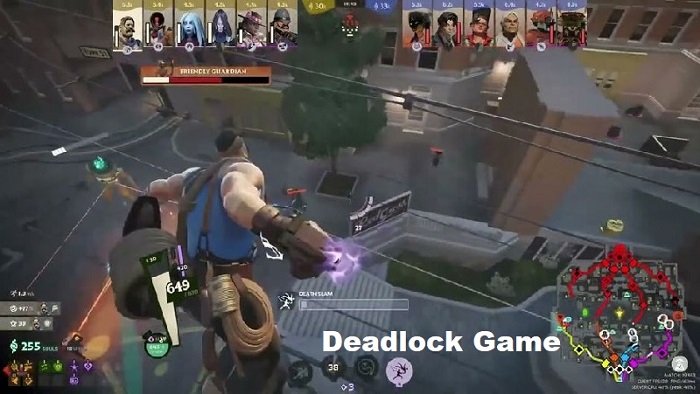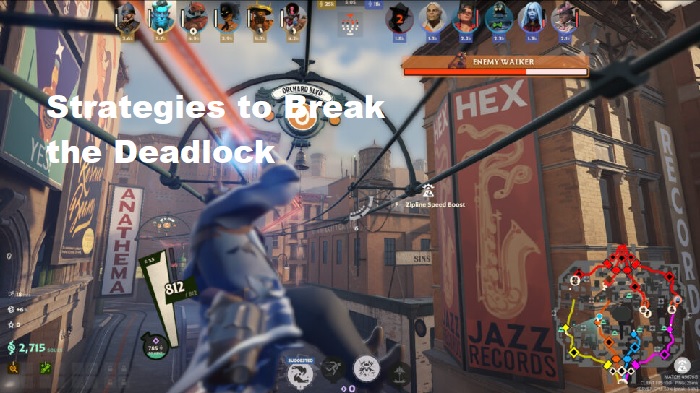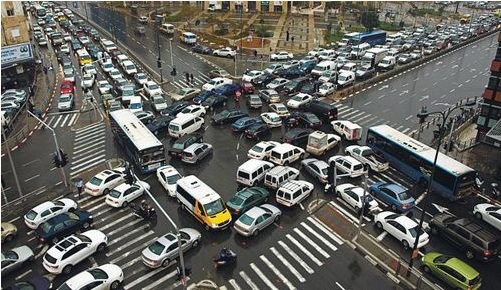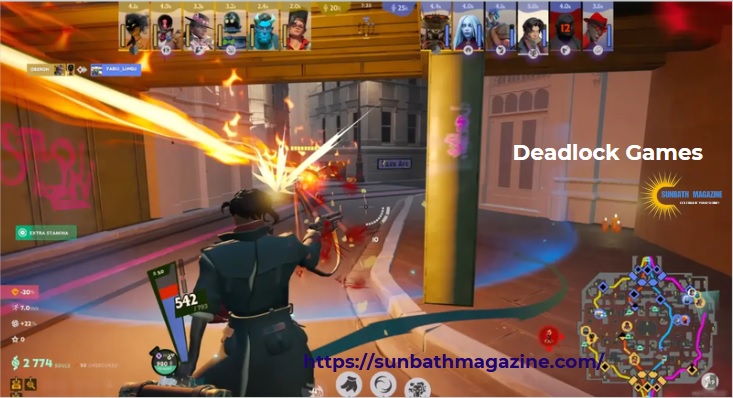The concept of deadlock is a term commonly used in computer science and game theory, where processes or agents become stuck in a situation where they are unable to move forward or complete their objectives. However, when it comes to Deadlock Game, the meaning shifts to a specific type of game that has gained attention due to its unique and exciting mechanics. The Deadlock Game is not just about strategy but also about critical thinking, competitive edge, and outsmarting your opponents.
In this article, we will dive deep into everything you need to know about the Deadlock Game. We will explore its mechanics, the rules that govern it, the types of players involved, strategies, and more. Additionally, we will look at how the game has evolved over time and its popularity in various gaming communities.
Whether you are new to the game or an experienced player, this guide will provide you with insights into mastering the Deadlock Game, improving your strategies, and having more fun while playing it.
Table of Contents
What is the Deadlock Game?

The Deadlock Game is a competitive, strategy-based game that involves players trying to outmaneuver each other in a situation where progress is hindered due to mutual interference or conflicting goals. The primary objective is to find a way to break the deadlock or gain the upper hand when both parties seem to be locked in an indefinite standoff.
In the context of gaming, deadlock refers to a point where players cannot make any progress because every move they make is blocked by the opponent. This can occur in various genres, such as board games, video games, and even in theoretical or abstract games used to teach decision-making or negotiation skills.
Deadlock mechanics are inspired by real-world situations in which players or entities are unable to make progress due to conflicting interests, lack of resources, or competing objectives. Understanding these dynamics is essential to unlocking creative solutions and breaking out of the cycle of deadlock.
Key Features of the Deadlock Game
- Strategic Gameplay: Every move in a Deadlock Game requires deep thought and careful planning. The game thrives on strategic thinking, requiring players to consider both their own goals and those of their opponents. The game often features resource management, positioning, and long-term planning.
- Tension and Conflict: At the core of the game is the deadlock situation itself, where players are trapped in a standoff. This creates tension, as players are forced to think outside the box to overcome their opponents and break free from the deadlock.
- Variety of Game Formats: The Deadlock Game can be adapted into different formats, such as board games, digital games, or card games. Each format offers unique ways to experience the game, with varying levels of complexity and different strategies.
- Multiplayer Dynamics: In multiplayer formats, Deadlock Games can involve various participants, and the game becomes even more complex when multiple players attempt to outwit each other. Coordination, alliances, and negotiations play a key role in determining the outcome.
Types of Deadlock Games
The term Deadlock Game can refer to several types of games across various categories. Here, we will outline some of the most common types of Deadlock Games that have gained popularity among players.
1. Board Games (Deadlock-style)
In traditional board games, a Deadlock Game refers to situations where players are unable to advance because they have blocked each other’s possible moves. Popular examples of such games include:
- Chess: In chess, a deadlock can occur when both players reach a position where neither can checkmate the other, resulting in a draw. The concept of “stalemate” in chess is a form of deadlock.
- Go: A board game involving territorial control, Go features deadlock situations where two opposing forces are locked in a constant battle, with neither player able to gain a clear advantage without making a critical move.
- Connect Four: A Deadlock Game can occur in Connect Four when all spaces are filled, and no more moves can be made. A player may also block another’s line of four, creating a perpetual deadlock situation.
2. Digital Deadlock Games
The Deadlock Game concept has been adapted into digital formats as well. These games often involve more complex rules and strategies that can involve puzzles, exploration, and combat. Here are a few examples of digital Deadlock Games:
- Deadlock: Planetary Conquest: This is a turn-based strategy game where players compete for control over planets. The game features deadlock situations, especially when two players are in competition for resources, and both are unable to make further progress without external help.
- Deadlock (2015): This is a puzzle game that presents players with a series of challenges where they need to work their way out of deadlock situations by solving complex puzzles.
- Deadlock: A Story-driven Game: A story-driven adventure game where the player experiences deadlocks within the narrative itself. The player’s actions and decisions result in deadlock situations that require creative solutions.
3. Card Games with Deadlock Mechanics
In some card games, players can also experience a deadlock situation. In these types of games, the deadlock occurs when neither player can outdo the other, and they are left with no strategic moves to advance the game. These include games like War, Hearthstone, and other competitive card games.
How Deadlock Games Work
The core of the Deadlock Game involves achieving an equilibrium between the players or parties involved, where no one is able to make meaningful progress. The players’ actions are often blocked by the opposing party, and the game requires them to find alternative strategies to break the deadlock.
In some games, players are given the ability to form alliances, make moves, and then counter the opponent’s strategies. The deadlock is often broken through innovative thinking, cooperation, or resourceful maneuvering.
Strategies to Break the Deadlock

Players involved in a Deadlock Game need to be adept at analyzing their current position and identifying potential ways to break the deadlock. Here are some strategies that can help players break the standoff:
- Resource Management: Understanding how to manage your resources effectively can give you a critical advantage. Being aware of your opponent’s resources and denying them access to important resources can help you gain the upper hand.
- Psychological Warfare: Some players try to break the deadlock by creating uncertainty and doubt in the opponent’s mind. Through bluffing, misleading moves, or feints, players may create opportunities where the opponent’s actions lead them into a vulnerable position.
- Reevaluate the Position: Often, players can only break the deadlock by changing the approach or reevaluating the entire situation. Thinking outside of the box and exploring unconventional moves may lead to breakthroughs.
- Collaborations and Alliances: In multiplayer settings, teaming up with other players can sometimes create opportunities to break the deadlock. However, alliances are temporary and should be handled with care as betrayal and competition are often a part of these games.
Importance of Critical Thinking
Critical thinking is an essential aspect of any Deadlock Game. Players need to analyze the situation from multiple angles, anticipate their opponent’s moves, and think several steps ahead. In many Deadlock Games, the longer the game goes on, the more complex the situation becomes. Players who possess superior critical thinking and strategic planning will often come out victorious.
Deadlock in Real-Life Situations

While Deadlock Games are fun to play, the concept of deadlock is also a real-life phenomenon. Deadlocks can occur in politics, negotiations, and even in business. In these scenarios, parties involved reach an impasse, and no progress is made. Understanding how deadlock works in a gaming context can offer valuable lessons for real-world conflict resolution.
For example, in international diplomacy, countries may find themselves in a deadlock situation where neither side can agree on terms. In business, deadlock might occur during contract negotiations where both parties are unwilling to compromise.
Learning how to handle deadlocks in a game can translate to improved decision-making skills in the real world, teaching players how to remain calm under pressure and look for creative solutions to seemingly impossible problems.
Popular Deadlock Games
Some games that feature the Deadlock concept are incredibly popular and widely played. These include:
| Game Name | Type | Platform | Description |
|---|---|---|---|
| Deadlock: Planetary Conquest | Strategy Game | PC, Console | A turn-based strategy game involving territorial control. |
| Chess | Board Game | Physical, Online | A classic game featuring deadlock situations such as stalemate. |
| Go | Board Game | Physical, Online | A game of territorial control, often involving deadlock. |
| Hearthstone | Card Game | PC, Mobile | A popular card game where players may face deadlock situations. |
| Deadlock: A Story-driven Game | Puzzle Game | PC, Console | A story-driven game featuring challenging deadlock puzzles. |
Summary
The Deadlock Game is a strategy-based game where players face off in situations where no progress can be made due to conflicting objectives. Whether in board games, card games, or digital games, deadlocks can provide challenging and thought-provoking gameplay experiences. Understanding the concept of deadlock can also be useful in real-world conflict resolution.
FAQs
1. What is a deadlock in a game?
A deadlock in a game occurs when players are stuck in a situation where neither can make any progress, leading to a standstill or impasse.
2. How do I break a deadlock in a game?
To break a deadlock, players can use strategies such as resource management, psychological tactics, and reevaluating their positions to find creative solutions.
3. Can deadlocks occur in real-life scenarios?
Yes, deadlocks are common in negotiations, politics, business dealings, and other real-world situations where conflicting parties cannot reach an agreement.
4. What are some popular deadlock-based games?
Some popular games that feature deadlock mechanics include Chess, Go, Deadlock: Planetary Conquest, and Hearthstone.
5. Is critical thinking important in deadlock games?
Yes, critical thinking is crucial in deadlock games, as players must analyze the situation, anticipate moves, and think several steps ahead to break the deadlock.
Disclaimer: The information provided in this article is for general informational purposes only. Game availability, prices, and features may change over time. Always check the latest updates from official sources for accurate details regarding Deadlock Games and related games.





